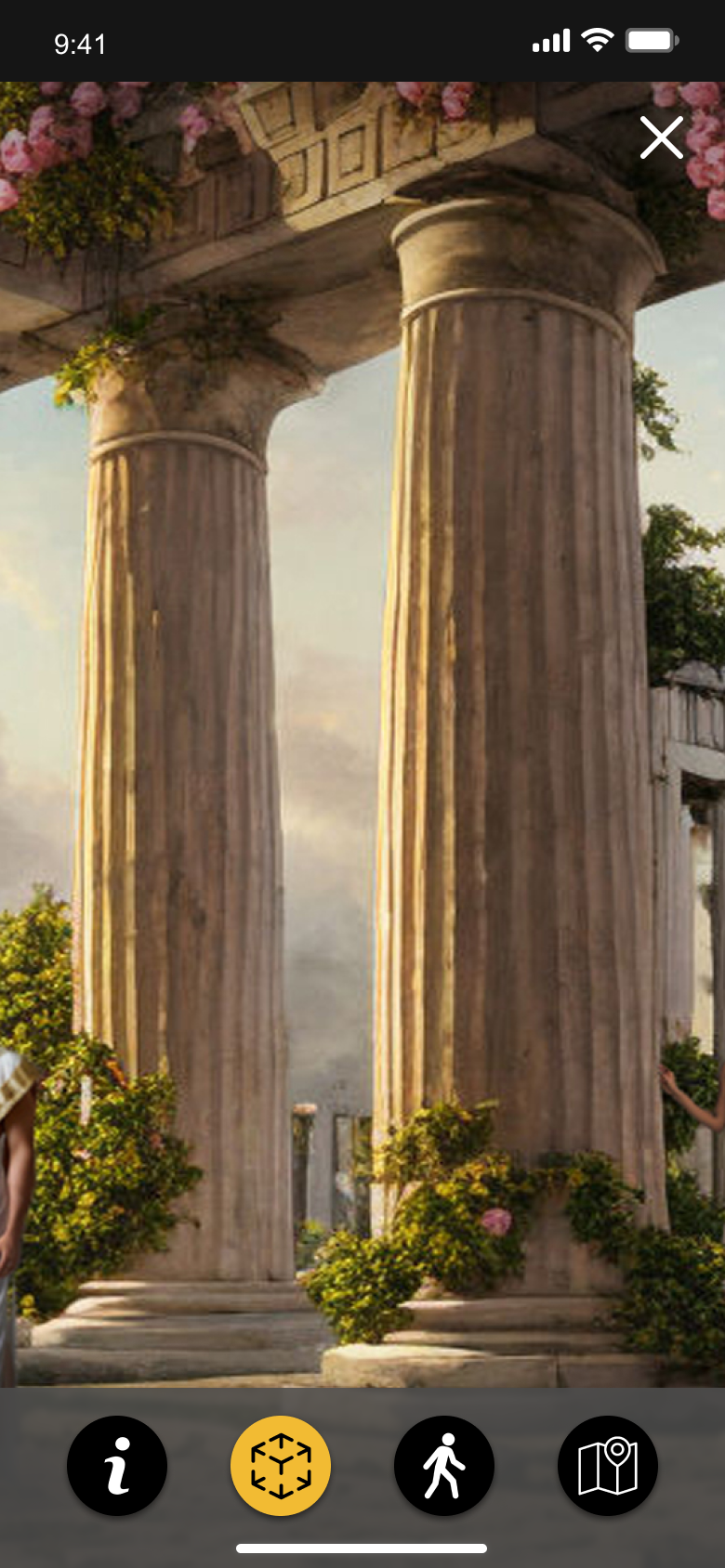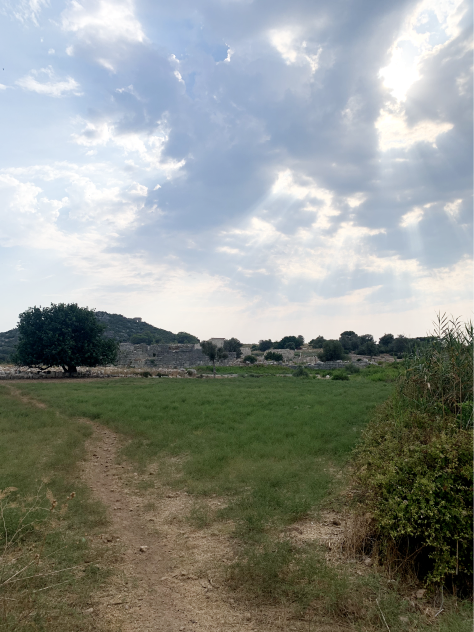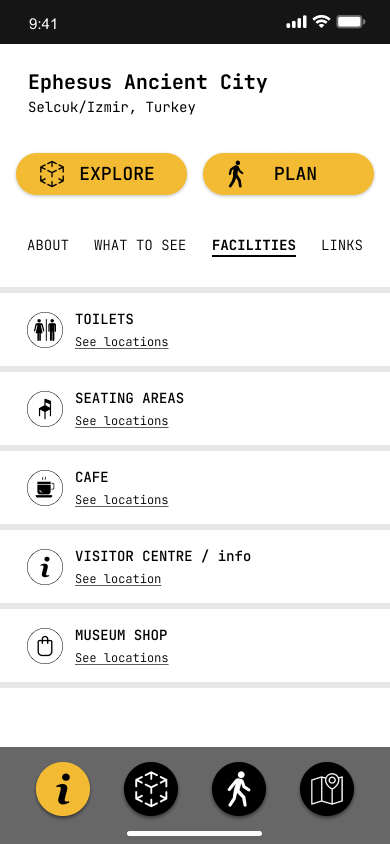Type:
Mobile App (iOS)
Company:
GA
Year:
2023
Role:
UX Research + UI Design Interactive prototyping, User testing
Tools:
Figma & Plugins, Notion
Adobe Suite (Photoshop and Premiere)
AI - Firefly, Playground
AR Tests - Adobe Aero
A passion project combining my architectural background and UX
With an architectural background as my foundation, this passion project has been a personal voyage of discovery, allowing me to harmoniously merge architecture, archaeology, and UX design. Throughout this endeavor, I've also had the exciting opportunity to delve into the realm of AI-generated imagery and grasp the essentials of Augmented Reality to craft effective wayfinding solutions. Guided by a genuine passion, I explored ways of designing the visitor experience in ancient cities with the possibilities of modern technology.





The Story
I visited the Archaeology Museums in Istanbul in August 2022. Within the exhibition rooms, there were large illustrations depicting the lifestyles of ancient times, such as people crafting pottery. You could view the pottery and artefacts displayed in the same room beside a representative olive tree. Seeing the illustrations helped me place these artefacts in context, resulting in a logical and memorable experience.
Later, I explored Patara Ancient City near Antalya, Turkey. Unfortunately, the visit didn't match the quality of the museum experience due to wayfinding issues and limited information available on-site. This led me to think, "Is there a way to enhance the visitor experience at these historic sites?




A visit to Istanbul Archaeology Museums

A diagram of the exhibition rooms in the museum
Large illustrations in each room
Artefacts
Olive Tree



During the interviews, users expressed their initial impressions of the homepage design, noting that it didn't reflect the boutique wine store's brand image due to the multi-colored deals. Additionally, the length of the homepage was a common frustration, as users found it unnecessary to scroll down.
VISITOR vs. ILLUSTRATION SCALE COMPARISON
As seen on large illustrations
Visual Reconstruction
Visual Reconstruction
Representation




A visit to Patara Ancient City

Personal Experience / Observations




Huge site, wayfinding issues
As seen on large illustrations
Goats?
Stones?
Stones?
Information Boards No one reads the whole text
Weather conditions - consistent sweating
NOT ENOUGH AMOUNT OF SIGNS, AT SOME POINT YOU DON’T KNOW WHICH WAY TO GO




"I don’t even know what I’m looking at"...says the architect!
Is there a way to create a better visitor experience at these historic sites? An open-air “museum” experience? Digital enhancements?
Problem Space / Opportunity
Research
My research journey began with Contextual Inquiry. I visited 6 diverse locations across Turkey and Greece—embracing ancient cities, historical sites, and museums—to understand whether the challenges I encountered at Patara were unique or part of a recurring pattern at these ancient sites.
Throughout the years in my architectural background, I engaged in numerous discussions with architects, designers, photographers, and tourists. However, to validate my observations, I conducted interviews with visitors to identify shared challenges and visitor pain-points.
Before moving forward, I explored existing products in the market to assess their offerings. Additionally, exploring references from Playstation games enriched my understanding of focal elements like location markers and enemy tagging.
Contextual Inquiry
Contextual Inquiry Findings
Condition of information boards - difficult to read the information
Wayfinding - no clear paths and lack of signage
Due to lack of information, visitors often make assumptions about the ruins and artefacts they see on site.
Visual reconstruction is challenging (even for the trained eye) due to the missing architectural elements and site constraints.
Observed body language and behaviour due to weather conditions, scale and condition of sites - frustration
Secondary Research



How can a VISITOR have a full experience without making the CONNECTION between the artefacts and the ARTEFACTS and the ANCIENT CITY?

Many artefacts excavated by foreign archaeologists in the 19th and early 20th centuries from sites like Ephesus, Pergamon, and Xanthos were taken abroad. Today, artefacts found on these sites are often transferred to museums due to the conditions of the historical sites.
Visitor Interviews

Conversations with Architects, Designers, Tourists, Photographers, Historians throughout the years
Interviews with Visitors
Affinity Mapping
Initial Findings


Ecosystem Mapping


Define
Using the insights and findings I gathered through research, I developed a persona that reflects common visitor challenges and needs. This led to defining the core problem and generating "how might we" statements.
Persona


Problem Statement
How might we...

Kate needs better on-site support at archaeological sites so that she can navigate, understand, and effectively engage with historic context.
enhance Kate’s visits to historic sites for more enriching and memorable experiences?
Visitor Journey

Ideate
I began by identifying the key features of the app, tying them back to my research findings. Since the project aims to enhance the on-site experience, I then proceeded with defining the features that would be implemented in the app. These features primarily revolve around wayfinding, providing information, and creating virtual/visual reconstructions of the ancient site.
Building upon these features, I created both simplified and more detailed user flows, outlining the steps involved. Continuing this process, I moved on to sketching ideas and exploring the layout of the app screens.
Key Features


Since the project aims to enhance the on-site experience, I proceeded with defining the features that would be implemented in the app - primarily focusing on wayfinding, providing information, and creating virtual/visual reconstructions of the historic sites.
Simplified User Flow


Detailed User Flow - Indicating Steps


Prototype
This project offered me a chance to explore new aspects, like AI integration. I looked into how AI technology could be used for image creation. I used Adobe Firefly and Playground AI to make images of ancient sites. After a few tests, the outcomes didn't match my expectations. I took an image created by an artist on Playground AI and edited it to match the angle of a photo I took during my site visits.
Then, I began designing the UI and screens of the app. Alongside, I made videos to demonstrate how wayfinding and virtual reconstruction work.
AI Tests - Image Creation
UI Design








Interactive Prototype


Click to Play Video
Sign up
Click to Play Video
Adding a Listener

Click to Play Video
Sign up

Adding a Listener
Click to Play Video

Click to Play Video
Sign up

Adding a Listener
Click to Play Video
Test & Outcomes
During usability tests, I received positive feedback from users. They valued the diverse ways of experiencing the site, facilitated by features like maps, route planning, and live exploration. While the overall response was positive, a few areas for improvement emerged. These include the implementation of a search bar within the map, addition of a profile icon, and iteration of the route planning screen.
What Worked?
What can be improved?
Overall, the usability tests were successful. Participants consistently highlighted the simplicity of the interface and how intuitive it felt to use. Features such as wayfinding, real-time navigation through AR, virtual reconstructions of ruins, detailed information about artefacts, and external links to museum resources were particularly well received.While feedback was largely positive, the tests also revealed a few areas where improvements could enhance the user experience further.
User Feedback
“The AR directions are very clearwhen walking.”
“I love the virtual reconstruction! Also it's easier to understand when I see the artefacts.”
"“It provides different opportunites to experience the site. Maps, route planning and live exploration. Good!”

Self Reflection
From engaging in site visits to conducting visitor interviews, exploring AI possibilities, and crafting UI designs, this project has been an absolute joy. My passion for archeology, background in architecture and my future in UX design came together in this project. This experience has ignited my motivation to further investigate AI for image creation and enhance my understanding of fundamental AR tools like Adobe Aero and possibly Unity.












